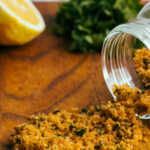Disclosure: This post contains affiliate links, which means I may earn a small commission if you make a purchase through them—at no extra cost to you. I only recommend products and tools I genuinely use, trust, or believe will add value to your cooking journey. Thanks for supporting the blog!
If you love adding a savoury, crispy finish to pasta and salads pangrattato might be your new favourite recipe.
This Italian classic — sometimes called “poor man’s Parmesan” — takes stale breadcrumbs, or panko in this case, and turns them into golden crispy bursts of flavour.
Let me show you how easy it is to make pangrattato from scratch, share pro tips for tasty results, answer common questions, and help you avoid the most common mistakes — so yours turns out delicious every time.
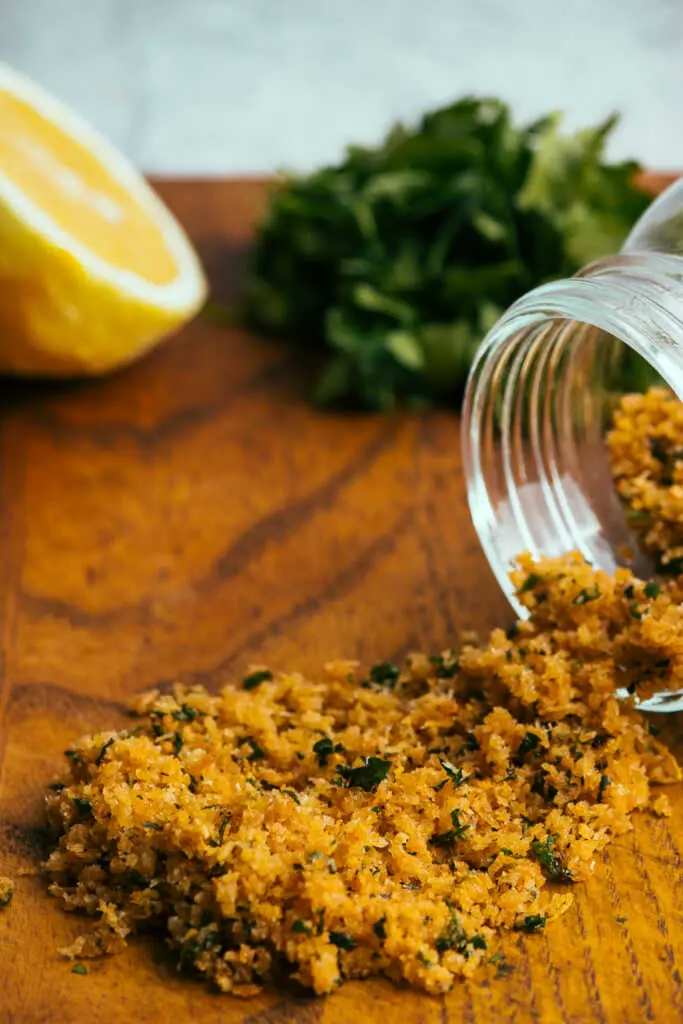
The first time I made pangrattato, I tried to jazz up a bowl of aglio e olio. I didn’t expect this simple breadcrumb topping to become a go-to flavour booster in my kitchen. Now, I always have a batch ready to go for pasta, soups, and roasted vegetables
Pangrattato means “grated bread” in Italian and was once known as the “poor man’s Parmesan.”
It originated in Southern Italy as a way to stretch stale bread into a crunchy, flavorful topping for pasta and vegetables. As The Columbian notes, it was used when cheese was a luxury—but today, it’s a chef’s trick for adding texture and savory depth to everyday dishes.
Pangrattato at a Glance
Storage: Airtight container, 1 week at room temp, or freeze up to 1 month
Ready in: 12 minutes
Main Ingredients: Panko breadcrumbs, butter, garlic, lemon zest, parsley
Best For: Pasta, salads, roasted vegetables
Flavour Profile: Buttery, garlicky, crispy, and fresh
What Is Pangrattato?
Pangrattato literally means “grated bread” in Italian.
It was created to make an affordable alternative to expensive Parmesan cheese. But today, pangrattato does its own thing, and is loved for the crispy texture and flavour it can add to dishes.
It’s way more than just breadcrumbs or stale bread, it’s an amazing ingredient you can use to elevate your cooking.
In some Italian regions, pangrattato is flavoured with anchovies, herbs, or chili to match the season.
Why Pangrattato Makes Food Taste Better
Pangrattato adds crunch, texture, and nutty, toasty flavours to soft or creamy dishes.
When you toast breadcrumbs in butter, you create the Maillard reaction — the golden browning that deepens flavour and brings irresistible savouriness to every bite.
Making Pangrattato: What To Know
I have made this recipe using panko breadcrumbs. Traditionally pangrattato is made using stale bread. The benefits of using stale bread is you get to choose how rustic you want your breadcrumbs i.e. chunky and crunchy or finer and crispier. My aim was to make this as more of a seasoning, so if you are looking to use these on soups, I would process your own stale bread as panko breadcrumbs are a bit too fine for soup – depending on the brand-and can turn soggy. You can swap the panko for stale bread in a 1:1 ratio, although depending on how rustic you like them, you might need to use less butter. I opted for butter in this recipe as I wanted as much flavour as possible, and think butter flavours the breadcrumbs better than the more traditional olive oil.
Sometimes called ‘poor man’s Parmesan,’ pangrattato originated in southern Italy as a clever way to use up stale bread. Today, it’s an amazing ingredient that can elevate any pasta or vegetable dish.
Ingredients
- ¾ cup of panko breadcrumbs
- 50g melted unsalted butter
- 2 large garlic cloves
- Zest of 1 lemon
- ¼ cup chopped fresh parsley
- Salt and pepper, to taste
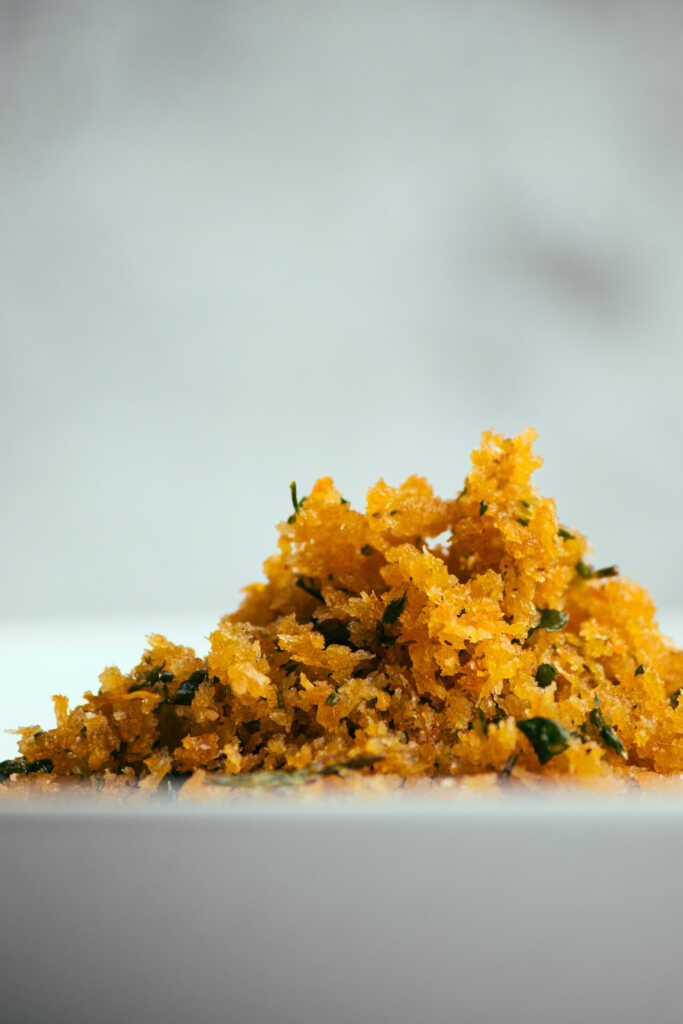
Equipment
How To Make Pangrattato
Toast the Garlic:
Heat the butter in a large non-stick skillet over medium heat. I like to peel and crush the garlic a little, but keeping it whole so the garlic flavour isn’t too strong throughout the finished breadcrumbs. Watch the heat, you don’t want to burn your garlic or it will go bitter and ruin the breadcrumbs.
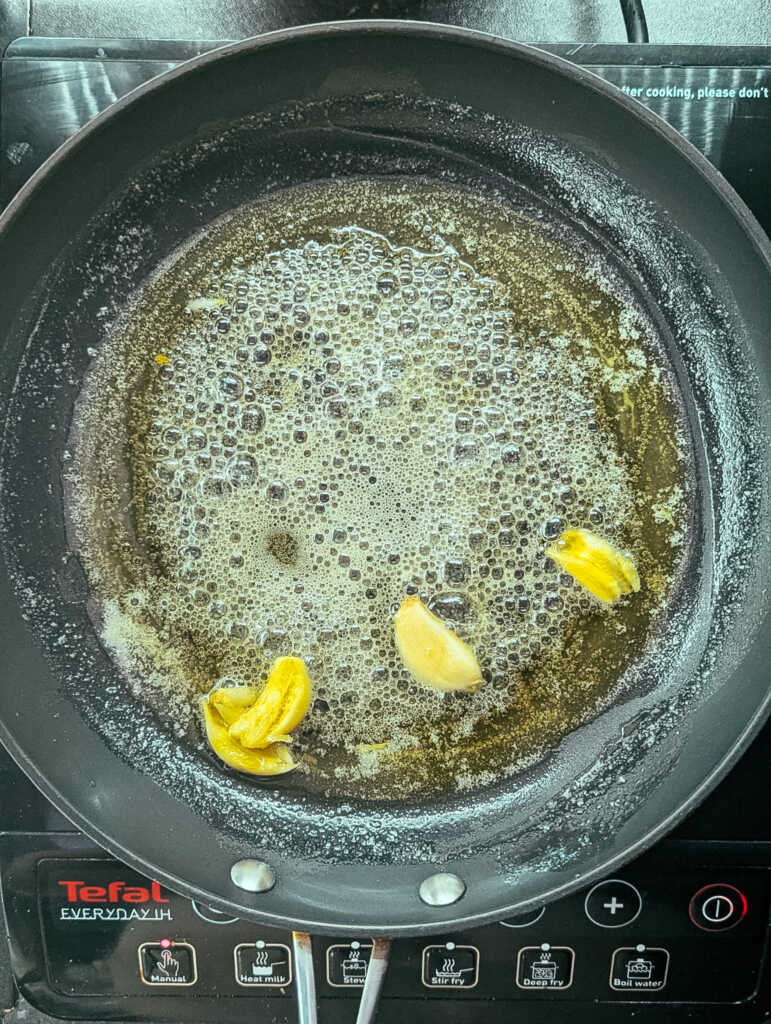
Toast the Breadcrumbs:
Add the breadcrumbs to the pan. Stir continuously to coat them evenly in the garlic-infused butter. Toast for 5–7 minutes until golden brown and crispy. You will notice the breadcrumbs turning golden and changing colour. Watch them carefully as they can burn very quickly.
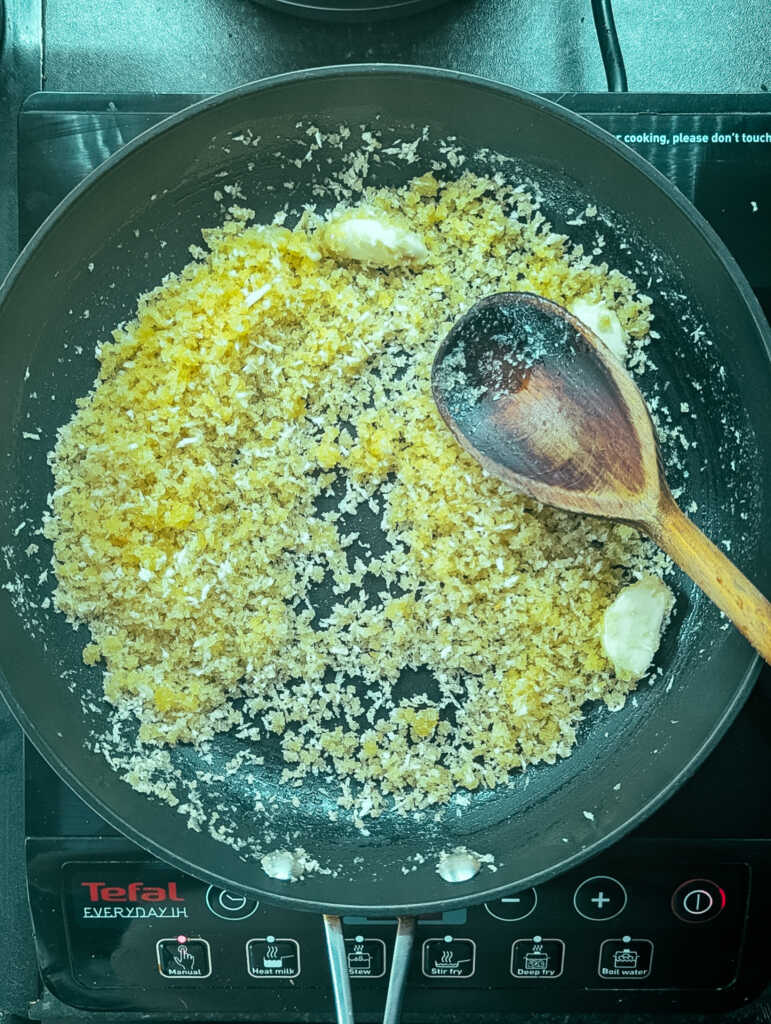
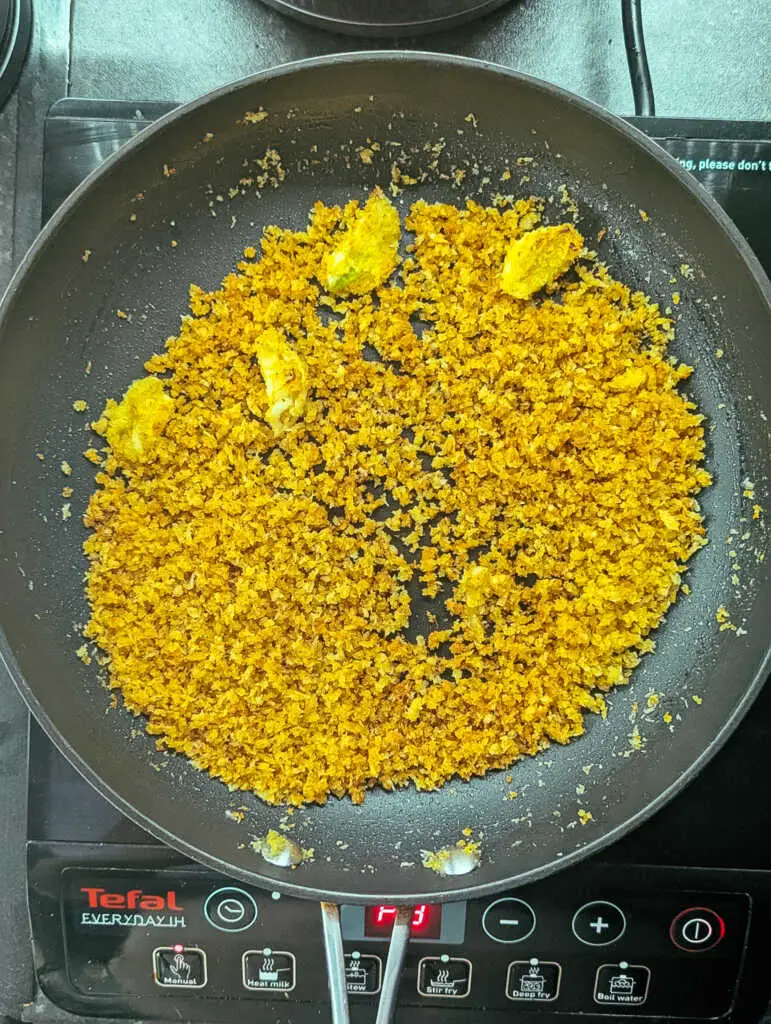
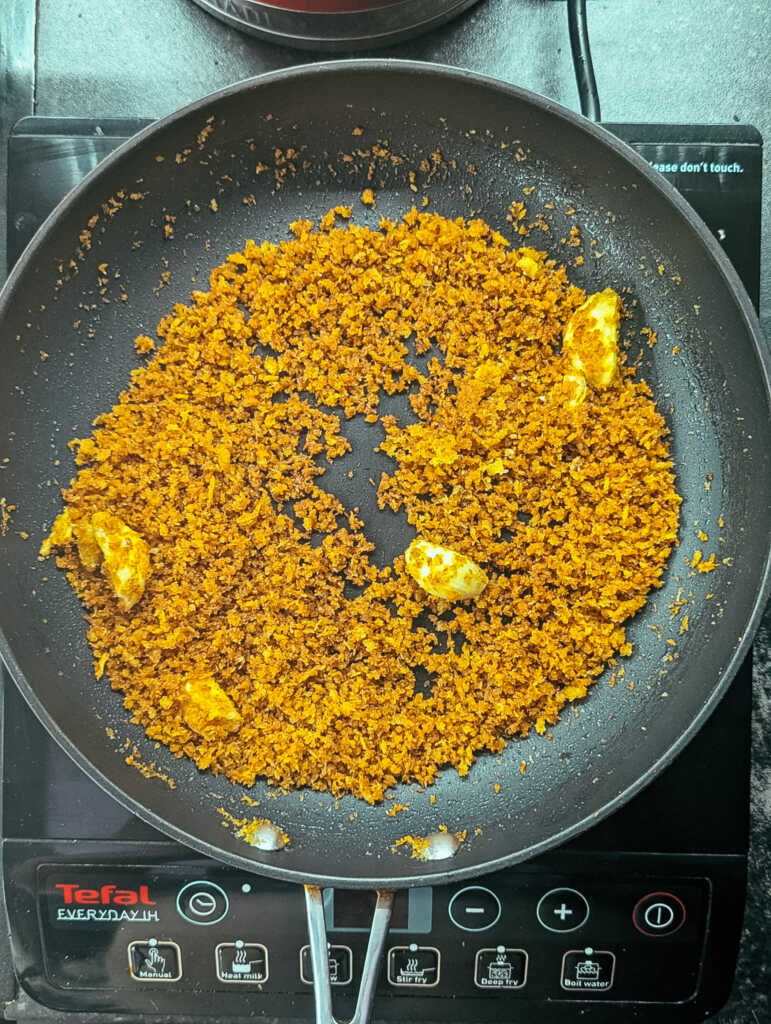
Add Flavour:
Once they are toasted and a good colour, stir in lemon zest and the parsley. Remove from the heat and season, tasting as you go so you get it how you like it. Remove the garlic cloves.
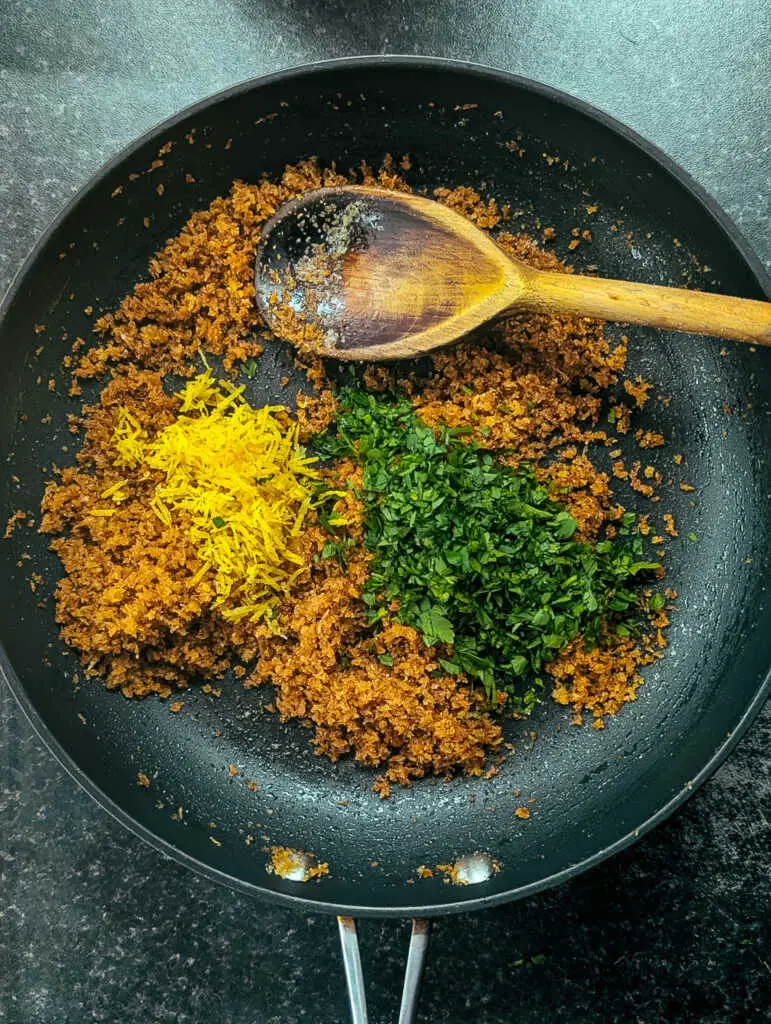
Cool and Store:
Add the breadcrumbs to a paper towel-lined bowl or plate to absorb any excess grease from the butter. Let them cool completely before storing them. Store in an airtight container at room temperature for up to 1 week.
Tips for Perfect Pangrattato
- Choose the Right Bread:
Use sturdy, rustic bread for the best crunch if using leftover bread. - Let It Dry Naturally:
If the bread isn’t fully stale, cube it and leave it out overnight to dry thoroughly or on a low heat in the oven till dry. - Low and Slow Toasting:
Toast breadcrumbs over medium to medium-low heat. If the heat is too high the panko will burn very quickly. - Flavour It Your Way:
Customize your pangrattato with:- Crushed red pepper flakes for a bit of heat
- Anchovy paste for a deep umami hit
- Use other fresh herbs, like rosemary and thyme
- Grated Parmesan for even more savoury flavour (watch the seasoning as parmesan will add plenty saltiness to the breadcrumbs)
Mistakes to Avoid
- Overprocessing the Bread:
If you decide to use your own stale bread, it can be useful not to overprocess it too fine. You will lose crunch and texture if the crumbs are like dust. - Burning the Garlic:
Garlic burns fast! Always sauté it gently before adding breadcrumbs. - Adding Fresh Herbs Too Early:
Fresh herbs can burn easily and turn bitter. Add them after toasting for the best results. - Skipping the Seasoning:
A little salt goes a long way when it comes to flavour. Don’t skip this small but crucial step. It will also help to keep the breadcrumbs crispy. - Storing While Warm:
Always cool pangrattato completely before storing. This will help to prevent moisture buildup and sogginess.
How to Use Pangrattato
Pangrattato is so versatile! Try it:
- Sprinkled over pasta: I love sprinkling this on my pasta like I would parmesan. Try using it on my penne aglio e olio or bucatini aglio e olio.
- Topping roasted vegetables: Adds a satisfying crispiness to broccoli, cauliflower, or Brussels sprouts.
- Finishing salads: Swap out croutons with pangrattato for a lighter, crunchier option on Caesar or arugula salads.
Tip: A handful of pangrattato can turn a basic meal into something special.
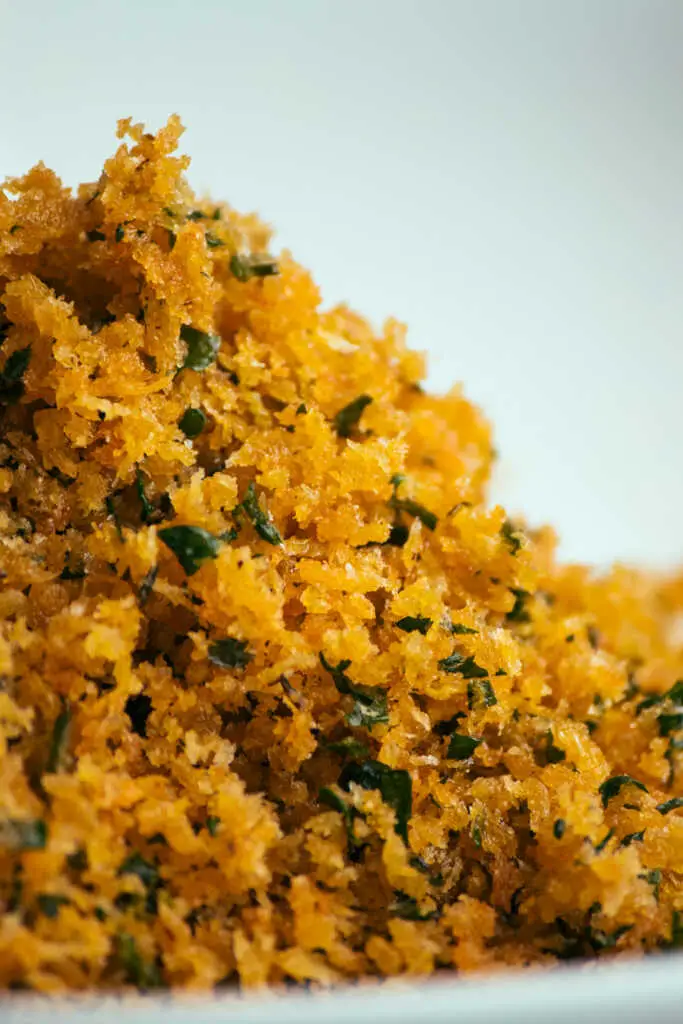
FAQ’s
Yes! Cool completely, then freeze in an airtight bag for up to 1 month. Re-toast briefly in a dry skillet to bring back to life.
About 1 week at room temperature in an airtight container.
Absolutely! Just make sure it’s a rustic-style loaf for best results (not overly soft white bread).
Traditional recipes don’t include cheese, but adding a little grated Parmesan makes it extra savory and delicious.
Let it cool completely, then store it in an airtight container at room temperature for up to 1 week.
It’s perfect on pasta, risotto, roasted veggies, soups, or even scrambled eggs!
Making pangrattato is easy, and an amazing way to add crunch and flavour to your recipes. Use it like I do – as a seasoning to bring your food alive!
With just a little stale bread/panko and a few pantry staples, you can make a topping that will lift your dinner recipes!
Why not give it a try tonight?
If you make your pangrattato with your own flavours — I’d love to hear what you come up with! Leave a comment below and share your favourite variation.
Try Another Recipe
How to Make Perfect Pangrattato (Italian Breadcrumbs)
Equipment
- 1 frying pan
- 1 box grater
- 1 chefs knife
- 1 wooden spoon
- 1 set of digital scales
- 1 set of measuring cups
Ingredients
- ¾ cup of panko breadcrumbs
- 50 g melted unsalted butter
- 2 large garlic cloves
- Zest of 1 lemon
- ¼ cup chopped fresh parsley
- Salt and pepper to taste
Instructions
- Toast the Garlic:
- Heat the butter in a large skillet over medium heat. Add the crushed garlic and sauté for 1-2 minutes to help flavour the butter
- Toast the Breadcrumbs:
- Add the panko to the skillet. Stir continuously to coat them evenly in the garlic butter. Toast for 5–7 minutes until golden and crispy. Make sure to keep stirring as they can burn.
- Add Flavour:
- Remove from the heat and stir in the lemon zest, parsley and seasoning. Remove the garlic cloves
- Cool and Store:
- Let the pangrattato cool completely on a paper-towel lined tray/plate before storing in an airtight container. Keeps well at room temperature for up to 1 week.
Notes
- These breadcrumbs need to be constantly stirred so they don’t burn. As you do this, you will notice they slowly start to change colour and become more golden.
- The texture of these breadcrumbs is quite fine, if you want more bite, replace the panko for stale bread and use a food processor to get the right ‘size’ of breadcrumbs.
- I have used unsalted butter, so that the seasoning can be controlled. You can use salted butter but be mindful of this when you come to season your breadcrumbs.

Hi, I’m Paul! I’m a passionate home chef, recipe developer, and food lover who believes that cooking should be fun, rewarding, and stress-free! Through Scoffs & Feasts, I share my favorite tried-and-tested recipes, cooking tips, and troubleshooting advice to help home cooks gain confidence in the kitchen. Whether you’re a beginner or an experienced foodie, I hope my recipes inspire you to try something new.

